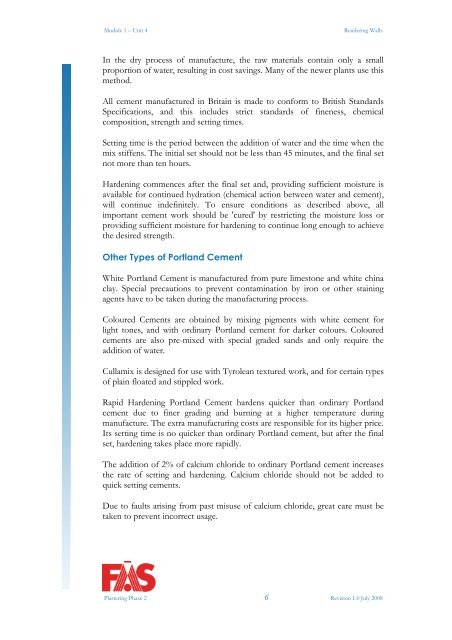TRADE OF PLASTERING - eCollege
TRADE OF PLASTERING - eCollege
TRADE OF PLASTERING - eCollege
You also want an ePaper? Increase the reach of your titles
YUMPU automatically turns print PDFs into web optimized ePapers that Google loves.
Module 1 – Unit 4 Rendering Walls<br />
In the dry process of manufacture, the raw materials contain only a small<br />
proportion of water, resulting in cost savings. Many of the newer plants use this<br />
method.<br />
All cement manufactured in Britain is made to conform to British Standards<br />
Specifications, and this includes strict standards of fineness, chemical<br />
composition, strength and setting times.<br />
Setting time is the period between the addition of water and the time when the<br />
mix stiffens. The initial set should not be less than 45 minutes, and the final set<br />
not more than ten hours.<br />
Hardening commences after the final set and, providing sufficient moisture is<br />
available for continued hydration (chemical action between water and cement),<br />
will continue indefinitely. To ensure conditions as described above, all<br />
important cement work should be 'cured' by restricting the moisture loss or<br />
providing sufficient moisture for hardening to continue long enough to achieve<br />
the desired strength.<br />
Other Types of Portland Cement<br />
White Portland Cement is manufactured from pure limestone and white china<br />
clay. Special precautions to prevent contamination by iron or other staining<br />
agents have to be taken during the manufacturing process.<br />
Coloured Cements are obtained by mixing pigments with white cement for<br />
light tones, and with ordinary Portland cement for darker colours. Coloured<br />
cements are also pre-mixed with special graded sands and only require the<br />
addition of water.<br />
Cullamix is designed for use with Tyrolean textured work, and for certain types<br />
of plain floated and stippled work.<br />
Rapid Hardening Portland Cement hardens quicker than ordinary Portland<br />
cement due to finer grading and burning at a higher temperature during<br />
manufacture. The extra manufacturing costs are responsible for its higher price.<br />
Its setting time is no quicker than ordinary Portland cement, but after the final<br />
set, hardening takes place more rapidly.<br />
The addition of 2% of calcium chloride to ordinary Portland cement increases<br />
the rate of setting and hardening. Calcium chloride should not be added to<br />
quick setting cements.<br />
Due to faults arising from past misuse of calcium chloride, great care must be<br />
taken to prevent incorrect usage.<br />
Plastering Phase 2 6 Revision 1.0 July 2008

















